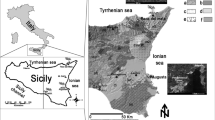Abstract
In the research, the contents of heavy metals, Al, Cd and Pb, in the hair of individuals who reside in similar environmental conditions were spectrometrically determined with the use of atomic emission spectrometry–inductively coupled plasma spectrophotometer. The relation to their tobacco smoking habit, age and sex was established. It was observed that the level of all three determined elements was generally higher in the hair of smokers in comparison to hair of non-smokers in both younger and older age groups. In addition, it has been observed that, in the group of elderly people over 50 years old, there was an increase in the content of aluminium, cadmium and lead both in smokers and non-smokers, irrespective of their sex. The sex-related differences in the content of the investigated elements were not unidirectional, and only in few cases did they reveal statistical significance.







Similar content being viewed by others
References
Stadlbauer Ch, Prohaska T, Reiter Ch, Knaus A, Stingeder G (2005) Time-resolved monitoring of heavy-metal intoxication in single hair by laser ablation ICP-DRCMS. Anal Bioanal Chem 383: 500–508
Paschal DC, Di Pietro ES, Philips DL, Gunter EW (1989) Age dependence of metals in hair in a selected U.S. population. Environ Res 48: 17–28
Eltayeb MAH, van Grieken RE (1990) Iron, copper, zinc and lead in hair from Sudanese populations of different age groups. Sci Total Environ 95: 157–165
Contiero E, Folin M (1994) Trace elements nutritional status, use of hair as a diagnostic tool. Biol Trace Elem Res 40: 151–159
Petering HG, Yeager DW, Withrup SO (1973) Trace metal content of hair. II. Cadmium and lead of human hair in relation to age sex. Arch Environ Health 27: 327–331
Kozielec T, Hornowska I, Kotkowiak L, Sałacka A (1993) Badanie zawartości ołowiu i kadmu we włosach u dzieci i młodzieży. Bromatol Chem Toksykol 26: 293–296
Zaborowska W, Wierciński J (1996) Oznaczanie ołowiu, kadmu, miedzi i cynku we włosach dzieci Lublina jako próba oceny zanieczyszczenia środowiska. Roczn PZH 47 (2): 217–221
Chojnacka K, Górecka H, Górecki H (2006) The effect of age, sex, smoking habit and hair color on the composition of hair. Environ Toxicol Pharmacol 22: 52–57
Unkiewicz -Winiarczyk A, Bagniuk A, Gromysz-Kałkowska K, Szubartowska E (2009) Calcium, magnesium, iron, zinc and copper concentration in the hair of tobacco smokers. Biol Trace Elem Res 128, 2: 152–160. doi:10.1007/s12011-008-8266-9
Chłopicka J, Zagrodzki P, Zachwieja Z, Kroceniak M, Flota M (1995) Use of pattern recognition methods in the interpretation of heavy metal content (lead and cadmium) in children’s scalp hair. Analyst 120: 943–946
Nowak B (1998) Contents and relationship of elements in human hair for a non-industrialised population in Poland. Sci Total Environ 209: 56–68
Nowak B, Chmielnicka J (2000) Relationship of lead and cadmium to essential elements in hair, teeth and nails of environmentally exposed people. Ecotoxicol Environ Saf 46(3): 265–274
Nikonorow M, Urbanek-Karłowska B (1987) Toksykologia żywności. PZWL, Warszawa
Szteke B (1987) Glin w środowisku człowieka. Rocz PZH 38: 29–35
Graczyk A, Długaszek M (1993) Procesy biochemiczne i mechanizmy molekularne toksyczności glinu. Roczn PZH 44: 23–41
Matczak-Jon E (1995) Rola glinu w środowisku. Wiad Chem 49: 483–500
Radomska K, Graczyk A, Konarski J, Adamowicz B (1991) Ocena zawartości makro- i mikroelementów w organizmie ludzkim na podstawie analizy włosów. Pol Tyg Lek 46: 461–463
Kozielec T, Sałacka A, Późniak J, Sałacki A, Karakiewicz B (2002) Występowanie kadmu i cynku w populacji ludzi dorosłych. J Elementol 7(2): 141–145
Leotsnidis M, Kondakis X (1990) Trace metals in scalp hair of Greek agricultural workers. Sci Total Environ 95: 1949–1956
Viena A, Capucci E, Wolfsperger M, Hauser G (1995) Heavy metal concentration in hair of students in Rome. Anthropol Anz 53(1): 27–32
Alesio L, Apostoli P, Forni A, Toffoletto F (1993) Biological monitoring of cadmium exposure—an Italian experience. Scand J Work Environ Health 19: 27–33
Bem EM, Piotrowski JK, Turzyńska E (1993) Cadmium, zinc and copper levels in the kidneys and liver of the inhabitants of north-eastern Poland. Pol J Occup Med Environ Health 6: 57–63
Bem EM, Orłowski C, Piotrowski JK, Januszewski K, Pająk J (1999b) Cadmium, zinc, copper and metallothionein levels in the kidney and liver of inhabitants of upper Silesia (Poland). Int Arch Occup Environ Health 65: 57–63
Wolfsperger M, Hauser G, Gossler W, Schlagenhaufen C (1994) Heavy metals in human hair samples from Austria and Italy: influence of sex and smoking habits. Sci Total Environ 156: 235–242
Bronisz H, Szost T, Lipska M, Zawada M (1983) Zawartość kadmu w papierosach. Bromatol Chem Toksykol 16(2): 121–127
Wiśniowska – Kielian B (1997) Dynamika pobierania kadmu, niklu oraz litu przez liście tytoniu papierosowego jasnego. Zeszyty Probl Post Nauk Roln 448 b: 345–353
Mortada WI, Sobh MA, El-Defrawy MM (2004) The exposure to cadmium, lead and mercury from smoking and its impact on renal integrity. Med Sci Monit 10(30): 112–116
Wibowo AAE, Herber RFM, Das HA, Rocleveld N, Zielhuis RL (1986) Levels of metals in hair of young children as an indicator of environmental pollution. Environ Res 40: 346–353
Razaqui IB, Ghribi I (2005) Maternal and neonatal scalp hair concentrations of zinc, copper, cadmium and lead: relationship to some lifestyle factors. Biol Trace Elem Res 106(1): 1–28
Rodriques JL, Batista BL, Nunes Ja, Passos CJ, Barbosa F Jr (2008) Evaluation of the use of human hair for biomonitoring the deficiency of essential and exposure to toxic elements. Sci Total Environ 405(1–3): 370–376
Ozden TA, Gulbin G, Ertem HV, Suoglu OD, Kilic A, Sokucii S, Saner G (2007) Elevated hair levels of cadmium and lead in school children exposed to smoking and in highways near schools. Clin Biochem 40: 52–56
Krechniak J (1990) Losy trucizn w organizmie. In: Seńczuk W (ed), Toksykologia. PZWL, Warszawa
Author information
Authors and Affiliations
Corresponding author
Rights and permissions
About this article
Cite this article
Unkiewicz-Winiarczyk, A., Gromysz-Kałkowska, K. & Szubartowska, E. Aluminium, Cadmium and Lead Concentration in the Hair of Tobacco Smokers. Biol Trace Elem Res 132, 41–50 (2009). https://doi.org/10.1007/s12011-009-8390-1
Received:
Accepted:
Published:
Issue Date:
DOI: https://doi.org/10.1007/s12011-009-8390-1




